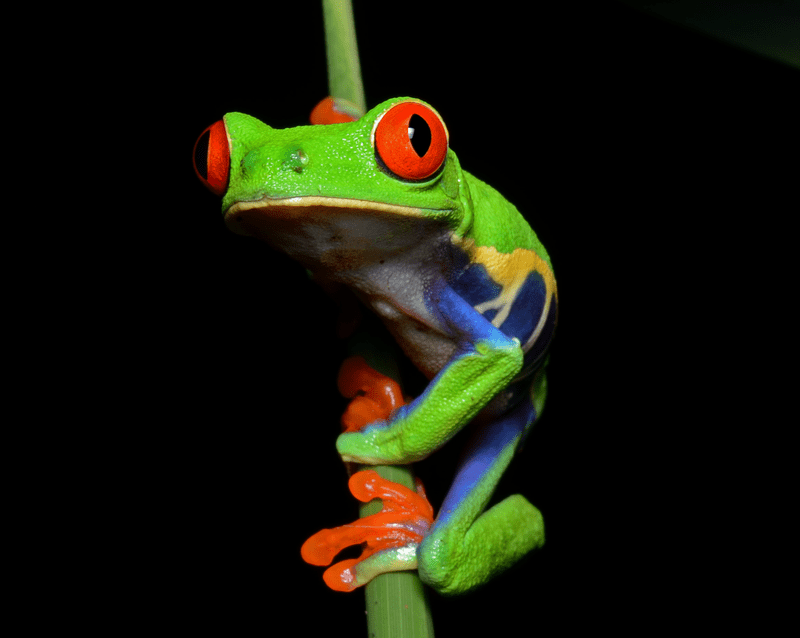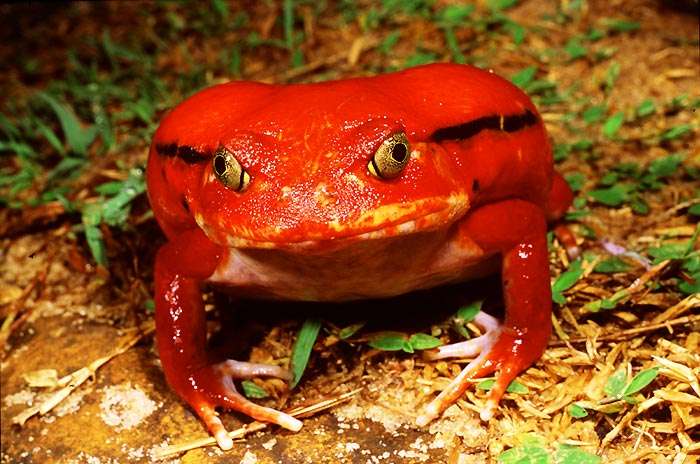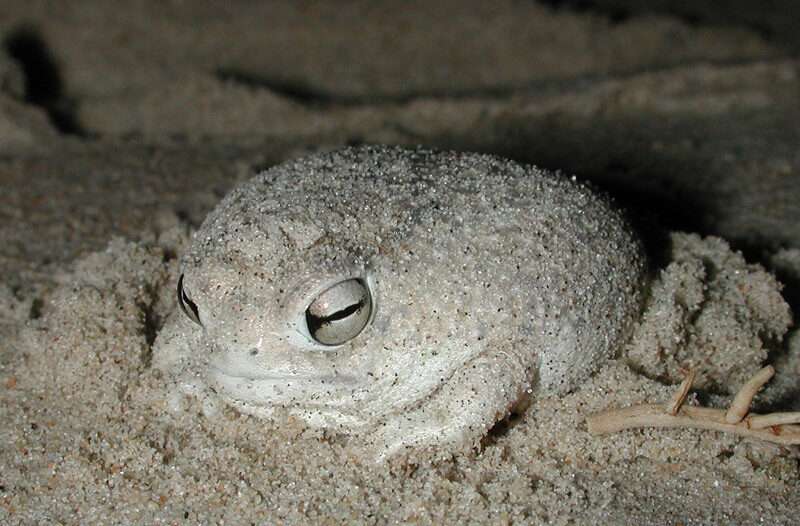
The Red Eyed Tree Frog, also known as Agalychnis callidryas, is a species of frog that belongs to the genus Agalychnis. The forests of Mexico, Central America, and northwest South America are the natural habitat for this genus. This species is distinguished by its vivid colouring, specifically its vivid green body with blue and yellow side stripes. It is named because of its recognizable bright red eyes, has a white bottom, and feet that are vividly coloured red and orange.
They are nocturnal and spend the most of the nighttime conducting insect hunting, just like all other members of the genus Agalychnis. This species’ males are smaller than the females, and they exhibit non-random mating behaviours that indicate female preference for particular male subtypes. Red-eyed tree frogs are not venomous, despite their vibrant colouring. Thus, the vibrant coloring can be more accurately attributed to the animal’s ability to blend in with the surrounding jungle’s vegetation and to use its “startle reaction” to deter predators.
Appearance
The distinctive features of red-eyed tree frogs include their vivid red eyes, beautiful green skin, and blue sides. They can climb and adhere to leaves because of the suction discs on their yellow-green toes. For each eye, they also have three eyelids. These creatures have a length of 2 to 3 inches (5 to 12.7 cm). The Red Eyed Tree Frog, also known as Agalychnis callidryas, is a species of frog that belongs to the genus Agalychnis. The forests of Mexico, Central America, and northwest South America are the natural habitat for this genus. This species is distinguished by its vivid colouring, specifically its vivid green body with blue and yellow side stripes. It is named because of its recognizable bright red eyes, has a white bottom, and feet that are vividly colored red and orange.
Reproduction
During the rainy season, reproduction occurs and is initiated by a mating ritual. To entice ladies, males croak and quiver. Red-eyed tree frogs deposit their eggs on the underside of a leaf that hangs above a body of water, and the eggs hatch within minutes. This process is highly sophisticated. The tadpoles then fall into the water and swim up.
Diet
The majority of the time, adult red-eyed tree frogs eat carnivorous insects like flies, grasshoppers, crickets, and moths. They occasionally consume smaller amphibians. Tadpoles consume vegetation, algae, plankton, bacteria, and dead animals. Froglets start eating tiny insects like fruit flies and pinhead crickets after they metamorphose. A study on the consumption of carotenoids revealed that they are crucial for development, phenotypic, and fertility. After metamorphosis, carotenoids increase both sexes’ skin colour and promote female development and fecundity during a vital window. For captive red-eyed tree frogs, who occasionally experience skin pigmentation degradation because of an inadequate diet, carotenoids are crucial nutrients.
Habitat
The red-eyed tree frog is a native of South America, notably the northern region of the continent as well as portions of Mexico and Central America. Belize, Colombia, Costa Rica, Guatemala, Honduras, Mexico, Nicaragua, and Panama are countries where the frog can be found.
Inland forests, marshes, and tropical and mountainous regions with surrounding water and forested areas make up its native habitats. They are always found close to ponds or other sources of water because they are necessary for their reproduction. In the previously mentioned nations, tropical rainforests are home to the red-eyed tree frog. The frog prefers to hide in the leafy canopy because it is essentially arboreal. High humidity levels of at least 80% are necessary for Agalychnis callidryas.
Keeping as Pet

Tank
Red-Eyed Tree Frogs need a lot of space to move around even though they are little, measuring just an inch or two in length. Even with just one tree frog, a terrarium must hold at least 15 to 20 liters of water. They prefer tanks that are taller rather than wider because they spend their entire lives in the rainforest canopies.
Substrate
One of the simplest decisions you will make is selecting the substrate for the tank. Orchid bark and coconut fiber substrate are two fantastic choices for a substrate, if your budget allows. A less expensive alternative that keeps the tank moist is damp paper towels. Even if they don’t look great, they work when you need them to.
Lighting and Temperature
Because UVB lamps are necessary for frogs to absorb calcium and vitamin D, lighting is essential to their overall health. To provide them with heat and light, we advise utilizing Zoo Med Reptisun lights with an additional LED bulb. To maintain daytime temperatures between 75°F and 80°F and overnight temperatures close to 70°F, place a digital thermometer in the tank.
Table





